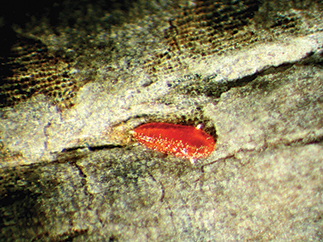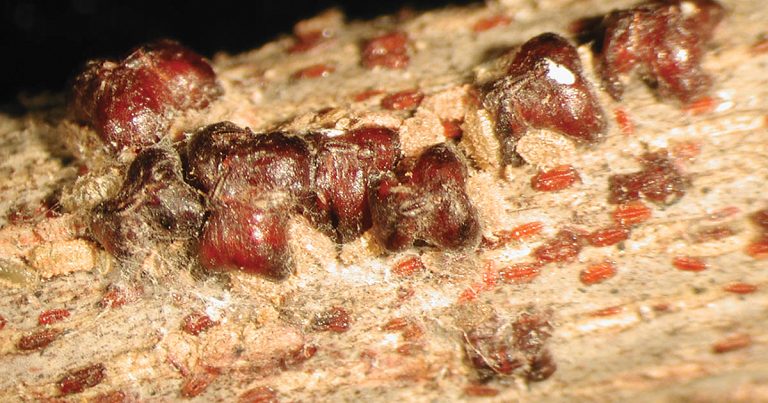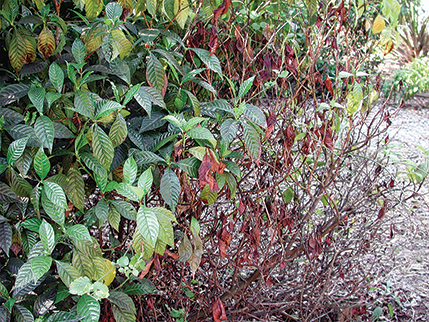Free printed copies of pest alerts are available.
Origin and Distribution
The lobate lac scale, native to India and Sri Lanka, was first reported on hibiscus in Broward County, Florida, in 1999 and was found on several other hosts in Broward and Miami-Dade counties in 2000. The scale was found in six additional southern Florida counties by 2004, and it has rapidly become a major pest. It also has been subsequently identified in some of the islands of the Bahamas. Lobate lac scale is a potential threat to many plant species growing in warmer U.S. climates, particularly where significant movement of living plants from Florida occurs.
Host Plants
More than 150 species of woody plants have been determined to be hosts of lobate lac scale in Florida, including 39 plant species native to Florida. Lobate lac scale most commonly attacks woody dicotyledonous plants, but it also has been found on one conifer (southern red cedar, Juniperus silicicola), on a palm, and occasionally on a few herbaceous species. Most of its exotic host plants are grown as ornamental shrubs or trees, or as fruit trees. Species that seem to be highly susceptible to attack include wax-myrtle (Myrica cerifera), cocoplum (Chrysobalanus icaco), buttonwood (Conocarpus erectus), strangler-fig (Ficus aurea), myrsine (Rapanea punctata), red bay (Persea borbonia), wild coffee (Psychotria nervosa), black-olive (Bucida bucerus), Indian laurel (Ficus macrocarpa), hibiscus (Hibiscus rosa-sinensis and Hibiscus spp.), weeping fig (Ficus benjamina), lychee (Litchi chinensis), mango (Mangifera indica), and carambola (star fruit, Averrhoa carambola). Lobate lac scale is not likely to be a problem in greenhouses, interiorscapes, or inside homes, but it can be a severe pest in the landscape and nursery.
Description of Lobate Lac Scale
The mature female scale is about 1.5–2.0 mm (approximately 1 ⁄16-inch) long and wide and has two pairs of prominent lobes (“bow-tie” shaped). The hard and brittle scale covering is generally a dark reddish brown, but it often seems dull and black due to a coating of sooty mold that forms on the scale. Although the honeydew produced by lobate lac scale is sufficient to produce sooty mold, ants do seem to be attracted to it. The crawlers (first instars) are elongate-oval, deep red, and very small (0.4 mm). Settled first instars are reddish brown and can be cryptic. The second instar begins to look like the adults in that it starts producing four prominent lobes, giving it its amoeba-like, bow-tie or X shape. Males of this species have not been observed.


Life Cycle
The lobate lac scale has four life stages: egg, first instar (crawler), second instar, and third instar (adult). The biology and life cycle of this scale are not well understood. Literature suggests that there should be one generation per year, and research in Florida indicates that the life cycle can be as long as 8 months. Newly emerged crawlers typically disperse by crawling to the nearest available food source; however, they also may be dispersed by air currents or wind. Once crawlers have settled on a new host, they remain immobile, maintaining the same feeding site for the remainder of their life.

Plant Symptoms and Monitoring
The lobate lac scale generally infests the woody portion of twigs and small branches. Less frequently, main stems of less than 2 cm in diameter are infested. On very susceptible hosts, high populations of the scale form a mass that looks like a dark, lumpy crust. Sooty mold growing on the honeydew secreted by the scale covers the scales and branches and occurs in patches on the foliage. Branch dieback occurs in some plant species due to dense scale infestations, and in severe infestations shrubs and small trees have died.
Management of lobate lac scale is difficult because 1) initial infestations are typically unnoticed due to their small size and the shape and color of the scale; 2) scales live for a long time; 3) scales infest natural areas where pesticide use is prohibited; 4) scales have a broad host range; 5) the thick, resinous coat may make scales impervious to certain insecticides; and 6) lack of natural enemies in Florida. Highly susceptible host plants in infested or suspect areas should be monitored regularly for the presence of this scale so that treatment can be made in the early stage of infestation.
Management Recommendations
Regular inspection and the use of insecticidal oils may be a successful management strategy because lobate lac scale population growth seems to occur very slowly. Horticultural oil applied to the branches and twigs can effectively manage populations in areas of low scale populations and reduce the spread to other plants. Depending on the level of infestation and weather conditions, oil applications need to be reapplied every 7 to 10 days for 4 to 6 weeks. Although some host plants tolerate this pest, it still may be important to manage it to reduce the spread to more susceptible plants. In more severe situations when the scale populations are high and there is significant plant damage, chemical insecticides may be necessary. Although not all products have been tested, the neonicotinoid insecticides show promise for controlling this pest.

Credits
This publication was produced and distributed by USDA–NIFA Integrated Pest Management Centers in cooperation with the National Plant Diagnostic Network, APHIS, and ARS.
Photo Credit: H. Glenn, UF/IFAS
Contributing authors: Catharine Mannion, Tropical Research and Education Center, University of Florida, IFAS; Forrest Howard, Fort Lauderdale Research and Education Center, University of Florida, IFAS; Greg Hodges, Florida Department of Agriculture and Consumer Services, Division of Plant Industry; Amanda Hodges, Southern Plant Diagnostic Network, Universith of Florida, IFAS. Editor: Julie Todd, Technically Correct Scientific Communications, State College, PA. Graphic designer: Gretchen Wieshuber, Studio 2D
This work is supported by the Crop Protection and Pest Management Program (2014-70006-22486) from the USDA National Institute of Food and Agriculture.
For information about the Pest Alert program, please contact the North Central IPM Center at northcentral@ncipmc.org.
March 2019

